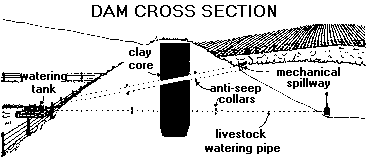Proper planning and construction are essential to building a pond that meets owner needs. Ponds are built for a variety of reasons, including watering livestock, fishing, recreation, wildlife or to enhance the beauty of a homestead. Each of these reasons require slightly different plans.
Many problems can be avoided if the pond is properly designed and constructed. Seek advice from the USDA Natural Resource Conservation Service (NRCS) for site selection, design and construction. Their agents can help with soil surveys, site selection, pond design, and construction. Check also with your county Soil and Water Conservation District (SWCD) and local office of the Iowa State University Extension Service. Iowa DNR fisheries biologists can also provide valuable input on site selection and watershed consideration for fishing and multiuse ponds.
Pond Watershed:
The best ponds in Iowa have 10 to 20 acres of watershed for each surface acre of water impounded. Protected timber is preferred as watershed cover. Other good watershed covers are grassland and pasture. Row crop is the worst watershed cover because silt loaded runoff shortens pond life and reduces fish populations.
Livestock Watering:
Ponds that have a small pipe (2 inch) in the lower part of the dam can be used to water livestock. The pipe should extend into the pond and connect with a standpipe, the top of which should be four feet lower than the water surface when the pond is full. A watering tank with a float valve placed below the dam will keep a steady water level in the tank. Using a watering pipe and tank to provide cool fresh water instead of letting livestock go into the pond will keep the dam and pond banks from being trampled by livestock. Contact your local NRCS office for help with designing one of these systems.

Pond Fencing:
Fence in the pond and dam to keep livestock out. Built the fence at least 60-100 feet from the pond edge. Livestock that have unlimited access to the pond can ruin the pond’s bank slopes and sod, weakening the dam and spillway. Livestock wading into the water will destroy fish spawning nests and create muddy water. A grass buffer strip inside the fence can reduce soil erosion and chemical runoff going into the pond.
Wildlife Benefits:
Most wildlife species need nesting or denning cover, a food supply, escape cover and winter cover. Lack of one or more of these needs may limit total population numbers. Buffer strips next to ponds provide critical nesting, denning, winter and escape cover for wildlife. This cover can also improve the quality of the water and increase the life of the pond by reducing soil losses from erosion.
Seeding areas next to the pond to grass or legumes can reduce erosion and provide wildlife nesting areas. Native warm season grasses such as Switchgrass, Indian grass or Big bluestem, provide excellent erosion control and wildlife habitat. Conifers can provide winter and escape cover. Other medium-sized trees such as mulberry and wild plum provide cover as well as food. Shrubs provide many benefits including food production, escape and winter cover and excellent nesting areas for wildlife. Contact your local DNR wildlife management biologist for technical help to plan for the best wildlife habitat around your pond. Your local county’s USDA office may offer help with the cost of adding wildlife habitat around your pond.